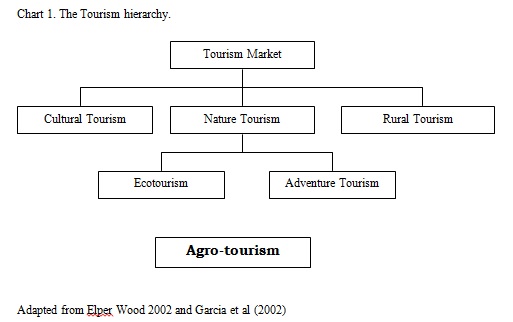Topics Covered in this Section
12.1 Unit Objectives and Textbooks
12.2 Definitions of Eco-tourism
12.3 The Concept of Ecotourism
12.4 Principles of the Eco-tourism Product
12.5 Philosophies and Foundations of Eco-tourism
12.6 Characteristics of a Successful Eco-tourism Site
12.8 Trends in Ecotourism Management
12.9 Keys to successful eco-tourism in Trinidad and Tobago
12.10 Guidelines in Eco-tourism
AGLS 6502 Lecture 12 - Organizations and Funding of Wildlife Management [Organization & Management]
12.1 Unit Objectives and Textbooks
Objectives
- To be able to understand the Economics of Wildlife Management
- To be able to appreciate the different methodologies at funding wildlife management.
Textbooks
- Willison, J,H.M., Bonrup-Nielsen, S. (1992). Science and the Management of Protected Areas. Elsevier
- Wright, R.G. (1992). Wildlife Research and Management in National Parks. U. of Ill. Press
12.2 Definitions of Eco-tourism
What is Eco-tourism?
For at least a decade The International Ecotourism Society (IES) (previously known as The Ecotourism Society) had already produced one of the first working definitions of Ecotourism. The definition states:
“Ecotourism is responsible travel to natural areas that conserves the environment and sustains the well being of local people” (Elper Wood 2002).
Likewise definitions coined by other researchers in the field of Ecotourism may include:
- “Visits to National Parks and other natural areas with the aim of viewing and enjoying the plants and animals as well as any indigenous culture” (Boo 1990).
- “Tourism that is environmentally sensitive” (Muloin 1991).
- “Tourism which is based upon relatively undisturbed natural environments, is non-degrading, is subject to an adequate management regime and is a direct contributor to the continued protection and management of the protected area used” (Valentine 1991).
- “Purposeful travel that creates an understanding of cultural and natural history, while safe guarding the integrity of the ecosystem and producing economic benefits that encourage conservation” (Ryel and Grass 1991).
- “Responsible travel to natural to natural areas which conserves the environment and improves the welfare of local people” (Lindberg and Hawkins 1993).
- “Tourism that involves traveling to relatively undisturbed or uncontaminated natural areas with the specific object of studying, admiring and enjoying the scenery and its wild plants and animals as well as any cultural aspects (both past and present) found in these areas” (Ceballos-Lascurain 1993).
- “An enlightening nature travel experience that contributes to the conservation of the ecosystem while respecting the integrity of host communities” (Cater and Lowman 1994).
- “Low impact nature tourism which contributes to the maintenance of species and habitats either directly through a contribution to conservation and/ or indirectly by providing revenue to the local community sufficient for people to value, and therefore protect, their wildlife heritage area as a source of income” (Goodwin 1996).
The International Ecotourism Standard has adopted the Ecotourism Associations of Australia’s definition of ecotourism:
“Ecologically sustainable tourism with a primary focus on experiencing natural areas that fosters environmental and cultural understanding, appreciation and conservation” (Chester et. al. 2002).
The Caribbean Forestry Conservation Association’s working definition of eco-tourism is as follows:
- “Eco-tourism is responsible travel to natural areas for spiritual, scientific, educational, recreational, and other visitor purposes, compatible with conserving the natural environment and sustaining the well-being of local people.”
12.3 The Concept of Ecotourism
In economic terms, ecotourism can be regarded as a market segment of the larger tourism market.
Chart 1. shows the tourism hierarchy in respect to ecotourism.

According to (Elper Wood 2002), the components of Ecotourism are as follows
- Contributes to conservation of biodiversity.
- Sustains the well being of local people.
- Includes and interpretation / learning experience.
- Involves responsible action on the part of tourists and the tourism industry.
- Is delivered primarily to small groups by small-scale businesses.
- Requires lowest possible consumption of non-renewable resources.
- Stresses local participation, ownership and business opportunities, particularly for rural people.
12.4 Principles of the Eco-tourism Product
The core set of eight principles that an ecotourism product should satisfy according to (Chester et.al 2002) are:
1. Focus on giving visitors the opportunity to personally and directly experience nature (Natural Area Focus);
2. Provide opportunities to experience nature in ways that lead to greater understanding, appreciation and enjoyment (Interpretation);
3. Represent best practice for environmentally sustainable tourism (Environmental Sustainability Practice);
4. Contribute directly to the conservation of natural areas (Contribution to Conservation);
5. Provide ongoing contributions to the local community (Benefiting Local Communities);
6. Be sensitive to, interpret and involve the culture/s existing in the area (Cultural Respect);
7. Consistently meets consumer expectations (Customer Satisfaction); and
8. Be marketed and promoted honestly and accurately so that realistic expectations are formed (Responsible Marketing).
12.5 Philosophies and Foundations of Eco-tourism
From the early conservation movements, to the momentum of rapidly emerging research and data from the various disciplines of the sciences, Eco-tourism was born long before it was characterized with the advent of international nature based businesses in the 1980’s.
Some examples of Eco-tourism at that time would be where tour operators sold nature trips to the Galapagos Islands, Costa Rica, Nepal and Kenya, (Elper Wood 2002).
A gathering of Eco-tourism certification experts at Mohonk Mountain, New York State, USA in November 2001 provided the first ever formal agreement (Mohonk Agreement)on Eco-tourism and other related activities (Chester et. al. 2002). Here the basic regulatory structures and framework for all Eco-tourism operations worldwide was decided upon and formalised for action.
12.6 Characteristics of a Successful Eco-tourism Site
- Natural attractions
- (natural backdrops, isolation and solitude)
- Viable, well protected ecological systems
- Trained on site staff
- (experienced persons in the group)
- Entrance fee system
- Human safety considerations
- (safety indicators, etc.)
- Education opportunities
- Visitors center
- Interpretive trails/information
- Amenities/
- (water, garbage disposal system, etc.)
- Monitoring systems
- Communication systems
- First aid support
- Appropriate transport
- Regulations and behavior codes with respect to
- Equipment
- People
- Conduct
- Nearby food/lodging
- A supportive local community
Some potential issues concerning eco-tourism
- Misuse of concept
- Conflicts of interest
- Public funding vs. User pay
- Poor planning & management
- Too mush emphasis on $$$
- Should locals pay?
- Exceeding carrying capacity
- Involving local community
- Under-budgeting/-staffing
Issues about revenues for managing protected natural areas
- Who pays?
- Cost recovery or profit?
- Are fees a supplement to our replacement for agency’s budget?
- Fees deposited in whose account?
12.8 Trends in Ecotourism Management
What makes an eco-tourist different?
- Motivation
- Education
- Participation
- Behaviour (ethics)
Site selection
- Purpose of the site
- Pre-selection of the site
- Duration of stay
- Sex composition of group
- Protected from adverse weather conditions
- Degree of safety in surroundings from potentially harmful creatures
- Know the proximity of sources of fresh, clean water
- Know the accessibility to other supplies
- Know the location of nearness health facilities
- Know the services offered at the nearest health facilities
Trends affecting the rise of eco-tourism
- Conservation seeking ways to integrate biodversity observation and sustainable development
- Travel industry seeking to provide more specialized tour options
Types of visitors to protected natural areas
- Casual visitors
- Casual eco-tourist
- Dedicated eco-tourist
- Researchers
- Do it yourselfers
- Group tours
- Study group
- Nationals
- Foreigners
- Consumptive users
- Non-consumptive users
Who reaps the profits from eco-tourism
- Travel agents
- Out-bound tour operators
- In-bound tour operators
- Local guides, vendors
- Lodging, meals, transport
- Government agencies
12.9 Keys to successful eco-tourism in Trinidad and Tobago
- A system of protected natural areas that fully embraces biodiversity
- A national parks and wildlife authority that is capable of managing that system
- A plan for development of compatible eco-tourism facilities
Trinidad and Tobago’s appeal to eco-tourism
- Concentrated, accessible biological diversity
- An already established reputation
- Diversity of opportunities
12.10 Guidelines in Eco-tourism
Adaptive management and the limits of acceptable change
- Select indicators for parameters of concern
- Establish standards for each indicator
- Monitor indicators
- If acceptable limits are exceeded, adapt management accordingly
Guidelines for the eco-tourist
- Self preparation
- Prior knowledge of the site
- Dietary preparation before the trip
- Proper clothing and footwear
- Behavioral coded expected
- Try not to disturb the flora on trails
- Cutlasses should not be exposed
- Safe and careful use of cutlasses and swiper blades
- Avoiding smoking in the forest
- Consult medical personnel on your fitness
- Avoid breaking vines and branches as they could contain irritating substances
- Keep foreign substances out of your eyes
- Be aware of information on hand
- Boo, E. (1990): Ecotourism: the Potentials and Pitfalls. Vols I and II. World Wildlife Fund, Washington D.C.
- Cater, E., Lowman, G. (1994): Ecotourism: A sustainable Option?, (Eds.) John Wiley and Sons Ltd., Chichester, England.
- Ceballos-Lascurain, H. (1993): Ecotourism as a worldwide phenomenon. In K. Lindberg and D.E. Hawkins (Eds.), Ecotourism : A guide for planners and managers (pp 12-14). the Ecotourism Society, North Bennington, Vermont, U.S.A.
- Chester, G., Crabtree A., Hundloe T., Lee, T. (2002): Setting a worldwide Standard for Ecotourism. the International Ecotourism Standard for Certification. Draft for Consultation. An Initiative of the Ecotourism Association of Australia’s, Nature and Ecotourism Accreditation Programme and the Co-operative Research Centre for Sustainable Tourism of Australia, in partnership with GREEN GLOBE 21.
- Internet Website http://www.ggasiapacific.com.au
- Elper Wood, M. (1993): Ecotourism Guidelines for nature tour operators. Published by the International Ecotourism Society, North Bennington, Vermont, U.S.A.
- Elper Wood, M.(2002): Ecotourism: Principles, Practices and Policies For Sustainability. United Nations Environment Programme Division of Technology, Industry and Economics. Production and Consumption Unit. France.
- Garcia, G.W., Young, G., Joseph, M. C. and Ramnarine, A (2002): Agro-tourism for Agro-environmental Linkages for Agricultural Development. University Certificate Programme in Agriculture by Distance, Faculty of Agriculture and Natural Sciences, UWI, St Augustine, Trinidad, Trinidad and Tobago.
